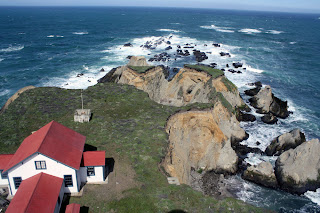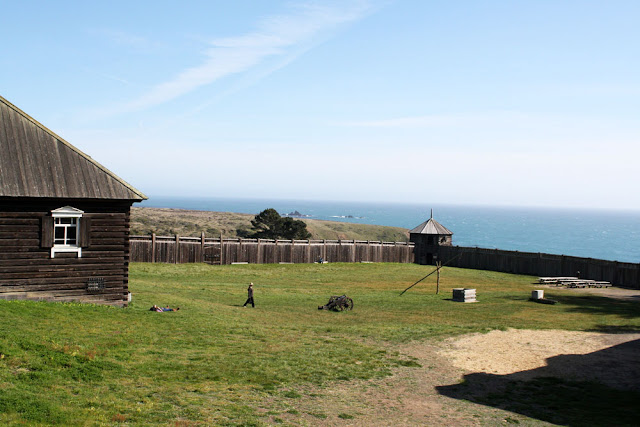We're way behind with blog posts over here. Embarrassingly behind. Since our last post, we took a mini-vacation to Seattle, stayed at a lighthouse, hit up all our usual haunts and watched the sun set from the highest point in San Francisco. We even have a new arts and crafts project to share with you. So without further ado, here's our first attempt to catch up, featuring Ben's birthday.
I wanted to plan a surprise for Ben's birthday: a weekend at a lighthouse. The idea for the surprise came from Ben himself, who back in September had mentioned the lighthouse while reading our
Northern California guidebook. Fortunately, that's the sort of information I remember and Ben quickly forgets, so I was psyched to steal his idea and surprise him. Except during the planning process, I somehow managed to confuse
this lighthouse with
this one, and once I got it all sorted out, I realized the lighthouse with lodging was 150 miles away up the coast. With Ben as our only driver, I figured I should let him in on the plan (plus, if it rained, the lighthouse would be nearly impossible to reach and I didn't want to be solely responsible for poor planning).
Ben's birthday rolled around and the sun gloriously stayed out so my (semi-)surprise was a go. We packed up our camping gear, which had been relegated to the closet during the (not very long San Francisco) winter, and boarded the bike. The route? One of our favorites roads: Route 1 (also known as the Pacific Coast Highway).
We've done the stretch of Route 1 between San Francisco and Point Reyes at least a dozen times now. We were making good time so we decided to detour onto one of favorite loops, which like that whole stretch of land, basically consists of beautiful rolling hills (it's remarkable how many photos I can take of these hills).
 |
| Lunch in Bodega Bay |
The real treat began past Bodega Bay, a stretch we had only done
in a car. Neither of us remembers anything special about it from our car trip, but on the bike, it was unbeatable.
 |
| Another major plus: the lack of cars |
Now I was a little nervous about our lodging. I had arranged to stay in the "Keeper's Room" at the Point Arena Lighthouse. The website description: "Our new Keeper's Room is a fully renovated space including Satellite TV, private bath, small seating area and a full view of the ocean, cliffs and lighthouse — even while laying in bed." But website descriptions aren't always to be trusted (in Patagonia one of our hotels was described as "a warm and comfortable stay" and there was barely room to move).
The first sign that I need not have worried: the view as we approached.
I didn't take any photos of our room, which was nice and cozy. There was a gas fireplace for heating, which was happily running when we arrived. The bed was comfortable and you really could see the lighthouse while lying in bed. It was, however, a bit windy.


Ben tries not to get blown away.
We got takeout for dinner and enjoyed the sunset.
Included in our room price was unlimited access to the lighthouse. Which brings me to the fact that I haven't mentioned whales at all. One of the reasons I had planned this trip was to see the gray whales that migrate up the coast from Mexico in mid-March. The whole drive up I kept my eyes on the water hoping I might see a whale. I knew this was a long shot, but the internet had led me to believe that there was a good chance of seeing whales at the lighthouse. We had even remembered our binoculars. But after climbing the lighthouse steps the next morning, we peered out onto the ocean and spotted ... not a single whale. And the lighthouse docent seemed very uninterested in helping us with our whale quest. We enjoyed the views, but eventually we had to descend without a whale sighting.
The first
Point Arena Lighthouse was built in 1870 but destroyed in the 1906 earthquake. The current lighthouse, at 115 feet tall, began operation in 1908. It featured a 1st Order
Fresnel Lens, over six feet in diameter and weighing more than six tons, with 666 hand-ground glass prisms. The light emitted by the lens was visible to mariners for 20 miles. The lighthouse is still an operational navigation aide today, with the light from the modern rotating light visible for 16 miles.
The next day we mostly spent exploring, including a stop at a vineyard near Steward's Point with bad wine but nice scenery and a tour of Fort Ross, an old Russian fur trading outpost. The fort, whose name was derived from the word for Russia, was originally established by the Russian-American Company, which controlled all Russian exploration, trade and settlement in North America. Chartered in 1799 by the czar, the company constructed Fort Ross in 1812 as a California outpost for hunting sea otters and provisioning Alaska operations.
The company's holdings extended as far south as Bodega Bay and more than 200 ships came through the port during its trading years. The fort compound housed living quarters for high-ranking officials, a Russian-Orthodox chapel and storage for food, furs and trading goods. Outside of the fort walls, the settlers built barns, wood and metal workshops, a ship works, tannery, two windmills for grinding grain and Russian-style bath houses.
The Russian American Company sold its holding in 1841 after 29 years on the California coast. The valuable fur seal had almost disappeared, the settlers weren't very successful in growing food and the company was spending more to run than the colony than it was making. The property changed hands several times before becoming a State Historic Monument in 1906. Since then, the fort has been slowly rebuilt to resemble how it looked during its days as a Russian outpost.


On the right, the view from one of the watchhouses
We had made reservations to camp at
Salt Point State Park, where Ben got to enjoy one of his Christmas presents (a bigger camping pot). We enjoyed another beautiful sunset while searching again (unsuccessfully) for whales. The next morning it was back to San Francisco. Not a bad birthday weekend, in my totally biased opinion.
 |
| Where will the road lead next? |
- Steph


 It's been a long time since I traveled by myself. In Argentina, Ben and I never split up while traveling (we did while in Buenos Aires, but we considered that our home). After I'd walked the waterfront and explored Pike's Place, I wasn't sure what to do. If Ben had been there, I might have spent more time tasting the free food at Pike's Place, but that wasn't nearly as much fun without someone to share it with. Instead, I decided to wander aimlessly.
It's been a long time since I traveled by myself. In Argentina, Ben and I never split up while traveling (we did while in Buenos Aires, but we considered that our home). After I'd walked the waterfront and explored Pike's Place, I wasn't sure what to do. If Ben had been there, I might have spent more time tasting the free food at Pike's Place, but that wasn't nearly as much fun without someone to share it with. Instead, I decided to wander aimlessly.


















































